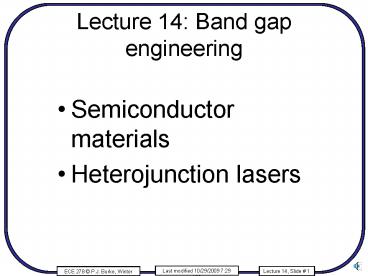Lecture 14: Band gap engineering PowerPoint PPT Presentation
1 / 40
Title: Lecture 14: Band gap engineering
1
Lecture 14 Band gap engineering
- Semiconductor materials
- Heterojunction lasers
2
Quasi-Fermi levels
Electron P(E)
Fn
energy
Ec
EFermi
energy
energy
Ev
Fp
1
P(E)
0
r(E)
Hole P(E)
3
Optical absorption/gain
Pump
Log(Iout/Iin)
0
frequency
Red equilibrium Blue pumped
Note huge frequency over which we get gain 1013
Hz!
4
Output spectrum
GaAs lasercleaved facet
p
What is output spectrum?
n
250 mm
5
Single vs. multi-mode lasing
MULTI-MODE
gain medium
Mirror
Mirror
Gain
Frequency
6
Output spectrum
GaAs lasercleaved facet
p
n
250 mm
From Carroll, Distributed Feedback Semiconductor
Lasers
But gain bandwidth applied voltage 10 THz! gt
multi mode oscillation
(Solution is DFB lasers.)
7
Optical fiber transmission
(Adapted from Streetman, Solid State Electronic
Devices)
8
Optical absorption/gain
Pump
Log(Iout/Iin)
0
frequency
Red equilibrium Blue pumped
Note huge frequency over which we get gain 1013
Hz!
9
Condition for gain
- Fn Fp gt Egap
- Both electrons, holes must have quasi-Fermi
levels out of gap! (draw on board) - This means HIGH density of electrons, HIGH
density of holes (1018 cm-3)
10
Diffusion
11
p n diode
n type
p type
eVo
EFermi
-
p type
n type
-
-
-
-
-
potential
12
Forward bias
n type
p type
e(Vo-Vf)
EFermi
EFermi
p
x
13
Laser diode
14
Laser diode
15
Recombination
b 10-10 cm3/s
16
Recombination
I
n
p
L
d
L
Steady state gt they must be equal!
What is d? Diffusion length, 1 micron
17
Band gap engineering
- Controlled growth of any structure you can
imagine in the z-direction - Important to LATTICE MATCH
- Dislocations/misfits INCREASE the non-radiative
recombination rate, causing higher laser
threshold currents - GaAs, InP typical substrates
- MBE, MOCVD, LPE
18
MBE
epitaxial growth
2.2 eV
1.4 eV
V
z
Also InP, InGaAs, InAlAs, InGaAsP
19
MBE
4 atom per layer!
(From Streetman, Solid State Electronic Devices)
20
Band gaps
21
Recombination
d0.1 micron
I
n
p
2.2 eV
L
1.4 eV
d
V
L
z
What is d? Diffusion length, 1 micron
What is d? You pick! 0.1 micron
22
p-i-n double-heterojunction (DH) lasers
I
p
n
i
- active region undoped
- fewer impurities
- lower non-radiative rec. rate
- lower thres. current
- p and n regions higher gap
- no optical absorption
- lower thres. current
- more efficient
V
x
- p and n different n
- better light guiding
- like total internal ref.
- usually solved numerically
n
x
E
But wavelength of light gtgt 0.1 microns!
x
23
Seaparate confinement heterostructure (SCH) lasers
I
p
n
i
V
x
n
x
E
x
24
Graded index SCH (GRINSCH)
I
p
n
i
V
x
n
x
E
x
25
Laser structures
GaAs lasercleaved facet
p
n
250 mm
250 mm
Which direction lases x or y?
26
Gain guided structures
Metal contact
Oxide
p
i
n
few mm
- No lateral carrier confinement
- No lateral light confinement
27
Gain guided structures
Metal contact
proton bombarded (damaged)
p
i
n
few mm
- Some lateral carrier confinement
- No lateral light confinement
28
Ridge structures
Metal contact
Polyimide
p
i
n
few mm
- Some lateral carrier confinement
- Some lateral light confinement
29
Gain-guided structures
- Easy to fabricate
- Only one MBE growth step needed
- Not very good lateral light confinement
- Not very good lateral carrier confinement
- Threshold current 100 mA
- More than one transverse mode lases
30
Etched mesa buried heterostructure (EMBH)
Metal contact
Regrown semiconductor (Higher bandgap)
p
i
n
few mm
- Excellent lateral carrier confinement
- Excellent lateral light confinement
31
Etched mesa buried heterostructure (EMBH)
Metal contact
Doped and diffused to have higher bandgap. (One
growth only.)
p
i
n
few mm
- Excellent lateral carrier confinement
- Excellent lateral light confinement
32
Channeled substrate BH
Metal contact
Substrate V etched before active region growth.
p
i
i
n
few mm
- Excellent lateral carrier confinement
- Excellent lateral light confinement
33
Buried heterostructure lasers
- Harder to fabricate
- Multiple MBE growth steps may be needed
- Very good lateral light confinement
- Very good lateral carrier confinement
- Threshold current 10 mA, much lower than
gain-guided structures - Single transverse mode
34
GaAs based (0.9 mm)
Metal contact
Oxide
p-AlxGa1-xAs
i-GaAs
n-AlxGa1-xAs
GaAs substrate
few mm
35
InP based (1.55 mm)
Metal contact
Oxide
p-InP
i-InGaAsP
n-InP
InP substrate
few mm
InP also makes fastest transistors (discussed in
ECE 217B next quarter) gt Opportunity for
integrated optics, electronics on one chip.
36
Quantum well lasers
d0.1 micron
I
n
p
2.2 eV
L
1.4 eV
d
V
L
z
What is d? Diffusion length, 1 micron
What is d? You pick! 0.1 micron
What if we pick d 0.01 micron QUANTUM WELL
37
Boundary conditions
We can do the same for y, z
L
L
L
If only one dimension is small, allowed k-vector
in that dimension quantized. kx, ky are
continuous A two-dimensional electron gas
results of only lowest kz is occupied.
38
Quantum well
d0.01 micron
Bound states
V
z
In HW, you showed density of states in 2d is a
CONSTANT.
bulk
quantum well
r (E)
E
39
VCSELs
- Vertically Coupled Surface Emitting Lasers
- Dont need to be cleaved
- Easier to couple to fiber
- Gain length less (set by growth in vertical
direction), so output power less - Typically 100 mW, vs. 100 mW for edge-emitting
lasers - Extra credit report?
40
Still to come
- DBR (Distributed Bragg Reflector)
- DFB (Distributed Feedback Laser)
- These are ways to make the laser oscillated
multimode.

